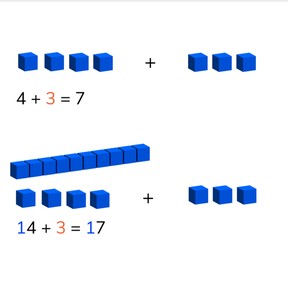



8,000 schools use Gynzy
92,000 teachers use Gynzy
1,600,000 students use Gynzy
General
Students learn to create a first step of addition by solving the problem without tens and then adding the tens after you solve the problem with ones.
Common core standard(s)
2.NBT.B.5
Relevance
It is important to learn to help make calculations easier and quicker.
Introduction
Start with some counting exercises to 100. Ask students to count out loud and ask them how they counted. It is useful, for example. to skip count in 5s or 10s. Then do a pop quiz on adding with totals to 20.
Development
Show students a set of addition problems in which simplification is visible. Ask students if they notice anything about the set of problems. They should notice that a tens is added to both an addend and the total. These are sets of addition problems. Tell students that you can calculate the total of an addition problem with tens faster if you first calculate the total without tens, you use that total as a first step. If you know 4+2=6, you can solve 14+2=16 and 24+5= 26 quickly and easily. Show this on the interactive whiteboard with the MAB blocks. Show them the problem 3 plus 6 by dragging blocks. Ask what the total is. Then show the problem 43+6. Ask how many blocks are in the total. Emphasize that they don't need to add 3+6 again, because they already know the answer, they simply must add 40 to the addend, and 40 to the total. You can ask students to do this on their desks with MAB blocks. Check that students are able to do this without blocks, using gum as representative visual support. First 5 plus 3, and then 15 plus 3, and then 25 plus 3. Show students the hundred chart and explain that this can help you when calculating the total of these problems. If you go to the right, the number has 1 added. If you go down, 10 are added. Do a few addition problems with the students without visual support. Discuss how many more are being added by looking at the sets of addition problems. Discuss how many are being added and fill that in on the interactive whiteboard. Discuss that this is also a part of the total and fill that in. Have students practice with a few problems. Finally, ask students if they are able to solve without a tangible support but imagine a MAB-set of 10 to add to the addend and total.
Check that students are able to add to 100 using simplification by asking the following questions:
- 6+2=8. 46+2 is?
- 4+3=7. 4+73 is?
- 8+8=16. Which addition problem can you now easily solve?
Guided practice
Students first do an addition problem in which they are given the first step and must calculate the total. Then students are asked to determine the total of the first step and the total, and finally they are asked to determine the first step as well as calculate the total.
Closing
Repeat the importance of this learning goal to the students. It is useful because it helps make calculation easier. If you can add without the tens, you can also solve the problem with tens. Check that students have understood by having the class solve two addition problems, one with visual support and a second without visual support.
Teaching tips
Students who have difficulty with this can be supported by the use of manipulatives like blocks or money. For example- give them a 5 dollar bill and a 1 dollar bill. Say that this is 5+1=1. Then give them a 10 dollar bill. The problem now is 15+1=16. If you give them another 10 dollar bill, they have 25+1=26. Emphasize that they don't need to solve 5+1 anymore because they have already solved it in the first step. They only need to add the tens. Students who are advanced can skip the first step and solve the problem in their heads.
Instruction materials
Optional: MAB-blocks or other manipulatives like money and printed hundred square
The online teaching platform for interactive whiteboards and displays in schools
Save time building lessons
Manage the classroom more efficiently
Increase student engagement
Discover more!
About Gynzy
Gynzy is an online teaching platform for interactive whiteboards and displays in schools.
With a focus on elementary education, Gynzy’s Whiteboard, digital tools, and activities make it easy for teachers to save time building lessons, increase student engagement, and make classroom management more efficient.



